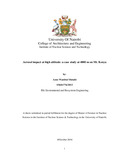| dc.description.abstract | One of the biggest challenges of the 21st century is climate change. It has been characterized by a rise of the mean temperatures of the ocean and air, thinning of glaciers and snow cover as well as rise in sea level. It has also been linked to extreme global weather conditions. Among the causes of climate change is elevation in the amounts of atmospheric aerosols and greenhouse gases, mainly as a result of anthropogenic activities. In order to quantify and mitigate these effects, it is important to have adequate observational aerosol data, from which; formation, chemical composition and transformations of the aerosols and trends can be obtained. Therefore, this study was aimed at understanding major air pollutants at high altitude, the need to improve understanding on aerosol sources and impact on glacial melting and the degradation of mountain ecosystems.
A sampling campaign for the study was carried out on Mt Kenya, the second highest mountain in Africa, from 2nd to 7th March 2015 and sampling done for 8 hours daily at sampling periods of 8 h per day for five days and two nights.
Instruments used for sampling were BGI 400S for PM2.5, MicroAeth Model AE51 for BC and GrayWolf pack for gases and particle counting. Quality control on EDXRF spectrometer was done using SRM 2783; Sensitivity, intensity and resolution were confirmed on TXRF spectrometer. Filter analysis was done using EDXRF spectrometer and glacier analysis in the TXRF spectrometer and the quantitative elemental analysis were done using AXIL and S2 Picofox software respectively. Basic and Multivariate, Principal Component analysis (PCA), statistics were used for data analysis.
PM2.5 concentration reported a range of 10 - 207 ng m-3 with elemental composition dominated by Ca and Fe with concentration ranges of 5854 - 26626 ng m-3 and 96 - 855 ng m-3 respectively. Daily BC mean concentration ranged between 123 - 263 ng m-3. Atmospheric gas that were significantly high throughout the study was CO2, which implied high oxidation of their precursors, CO. This was observed as the reason why there was no O3. In the dirty glacier; K, Ca, Ti, V, Mn, Fe, Cu and Br were higher than in the clean glacier samples. However, Cr and Ni remained equal in both glacier. The PCA analysis results of elemental concentrations gave two components showing PM2.5 particles were mainly
xi
from mineral dust and industrial sources. However, the industrial source was weaker than the mineral dust implying a strong impact of dust at the measurement site. The observations in this study, implicated impact of long and short range transport which one would expect in the middle troposphere. However, further short term studies and spaced in time over the year are recommended. The best alternative to spaced short term studies is installation of an automatic sampling site, which could be supported by validated by random
short term studies. | en_US |



